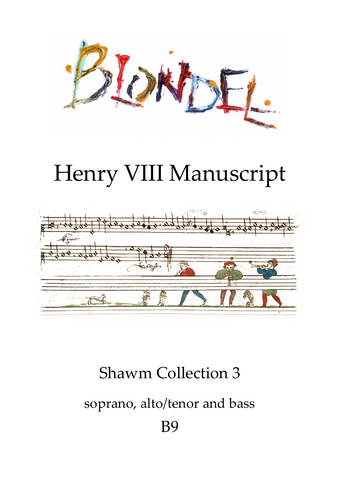
B9 Henry VIII Manuscript: Shawm Collection 3: S A/T B shawms (also suitable for recorders)
orders placed after November 29th 2024 will be dispatched in the week beginning January 6th 2025
Contents
Pastime with good company: Henry VIII (1491-1547)
Time to pass: Anonymous
Adieu, adieu my hertes lust: William Cornysh (1465-1523)
Si fortune: Anonymous
What remedy?: Anonymous
Jay pryse amours: Anonymous
How to use this book
I’ve tried to make this book as flexible as possible. The first third contains editions of each piece for shawms in D, G and C at sounding pitch, the second third for shawms in C, F and C at sounding pitch, and the final third for players of shawms in D and G who prefer to read in F and C fingerings.
The Henry VIII Manuscript (BL Additional MS 31922) dates from around 1518 and is
the most modern of three large songbooks surviving from the period. It contains more
music ascribed to Henry VIII than to any other composer and clearly belonged to
somebody closely associated with his court—probably Sir Henry Guildford, Controller of the Household and Master of the Revels.
Henry VIII was highly regarded as a composer and performer during his lifetime,
possibly because nobody was willing to tell the King he wasn’t very good. A number of pieces in this volume are genuinely his work—they tend to stand out as a result of their slightly clumsy style. He also made arrangements of works of other composers, and laid claim to several pieces that are clearly not his work at all.
The collection also includes a number works by foreign composers such a Heinrich Isaac and Hayne van Ghizeghem, and 76 pieces by musicians associated with Henry's court, such as William Cornysh and Robert Fayrfax.
William Cornysh was a composer, poet, dramatist, organiser of revels and performer. He became a member of the Henry VII’s Chapel Royal in 1494, and Master of the Children of the Chapel Royal by 1509. He organised the pageants devised for the marriage of Prince Arthur and Catherine of Aragon, as well as those held at the Field of the Cloth of Gold in 1520.